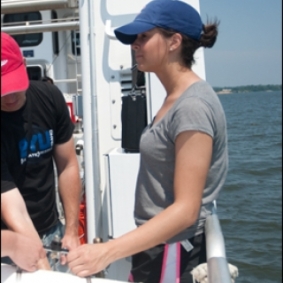Eight students will be presenting the summer work at the Ocean Sciences Meeting in March 2022!
Whitley Gilbert, Iowa State University
Class Year:
2010Mentor:
Tom Fisher, Ph.D.Project Title:
Determining Denitrification through the Measurement of Excess N2 in Upwelling Groundwater in Choptank River Streams
Abstract:
This study was designed to determine whether denitrification was occurring in stream beds within the Choptank River Basin. Denitrification was measured by the amount of excess N2 found in the groundwater flowing into piezometers installed 20-60 cm below the stream bed of a channelized farm stream. I hypothesized that the groundwater flowing into the stream from adjacent lands was the primary source of excess N2 in the stream sediments, meaning denitrification is primarily occurring in soils and groundwater distant from the stream and not within the streambed. My alternate hypothesis was that denitrification is occurring within the stream sediments and augments the vertical distribution of excess N2 entering the stream from groundwater. Sampling in July 2010 produced results, which showed significant inverse correlations between NO3, O2, and excess N2 that indicated an environment suitable for denitrification. However, excess N2 concentrations decreased from 40 cm to the surface of the streambed, suggesting that advective loss to the surface waters flowing above was the most important process influencing the vertical distribution of excess N2 concentrations. Thus, denitrification was only concluded to be occurring in the deeper layers at one sampling site.
Location:
Horn Point LaboratoryPresentations:
Gilbert, W.*, and T. Fisher. 2011. Determining denitrification through the measurementof excess N2 in upwelling groundwater in Choptank River streams . ASLO Aquatic Sciences Meeting, San Juan, Puerto Rico .




